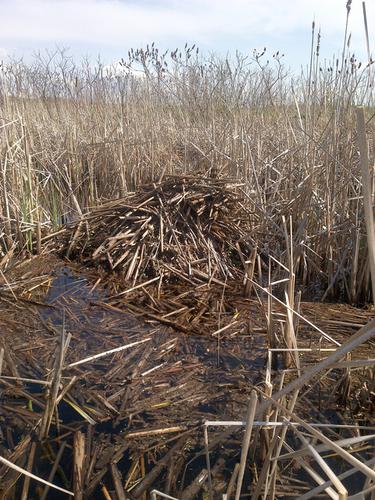当前位置:
X-MOL 学术
›
Ecol. Evol.
›
论文详情
Our official English website, www.x-mol.net, welcomes your feedback! (Note: you will need to create a separate account there.)
Historical surveys reveal a long-term decline in muskrat populations
Ecology and Evolution ( IF 2.6 ) Pub Date : 2021-05-02 , DOI: 10.1002/ece3.7588 Carrie Sadowski 1 , Jeff Bowman 1
Ecology and Evolution ( IF 2.6 ) Pub Date : 2021-05-02 , DOI: 10.1002/ece3.7588 Carrie Sadowski 1 , Jeff Bowman 1
Affiliation

|
The muskrat (Ondatra zibethicus) is an iconic species in Canada, valued for both its fur and its integral role in wetland ecosystems, and widely regarded for its perseverance. However, the resilience of this semiaquatic mammal seems to be in question now as increasing evidence points to widespread population declines. Recent analyses of harvest data across North America suggest a reduction in their numbers, but this has not been widely corroborated by population surveys. In this study we replicated historic muskrat house count surveys at two large Great Lakes coastal wetlands and present confirmation that declines in muskrat harvest correspond to actual declines in muskrat abundance. At the Point Pelee National Park marsh and the Matchedash Bay-Gray Marsh wetland we found that mean muskrat house counts declined by 93% and 91% respectively between historic surveys 40–50 yrs ago and contemporary surveys over the past 7 yrs. The factors responsible for these dramatic declines remain unclear but there may be a relationship with changes in the habitat quality of these wetlands that have occurred over the same time frame. Not only is the loss of muskrats an issue for the resulting loss of the wetland ecosystem services they provide, but it may be an indication of broader marsh ecosystem degradation. As such, a scarcity of muskrats should be considered a red flag for the state of biodiversity in our wetlands. Continued surveys and ongoing research are needed to shed more light on the current status of muskrat populations and their marsh habitats across their native range.
中文翻译:

历史调查显示麝香鼠种群长期下降
麝香鼠 ( Ondatra zibethicus) 是加拿大的标志性物种,因其皮毛和在湿地生态系统中不可或缺的作用而受到重视,并因其坚韧不拔而广受赞誉。然而,随着越来越多的证据表明人口普遍下降,这种半水生哺乳动物的恢复能力现在似乎受到质疑。最近对北美收获数据的分析表明它们的数量有所减少,但这并没有得到人口调查的广泛证实。在这项研究中,我们在五大湖沿海湿地复制了历史悠久的麝香鼠房屋数量调查,并证实麝香鼠收获的下降与麝香鼠丰度的实际下降相对应。在 Point Pelee 国家公园沼泽和 Matchedash Bay-Gray Marsh 湿地,我们发现在 40-50 年前的历史调查和过去 7 年的当代调查之间,麝香鼠的平均数量分别下降了 93% 和 91%。造成这些急剧下降的因素尚不清楚,但可能与这些湿地栖息地质量在同一时间范围内发生的变化有关。麝香鼠的丧失不仅是导致它们提供的湿地生态系统服务丧失的一个问题,而且可能表明更广泛的沼泽生态系统退化。因此,麝香鼠的稀缺应被视为湿地生物多样性状况的危险信号。
更新日期:2021-06-22
中文翻译:

历史调查显示麝香鼠种群长期下降
麝香鼠 ( Ondatra zibethicus) 是加拿大的标志性物种,因其皮毛和在湿地生态系统中不可或缺的作用而受到重视,并因其坚韧不拔而广受赞誉。然而,随着越来越多的证据表明人口普遍下降,这种半水生哺乳动物的恢复能力现在似乎受到质疑。最近对北美收获数据的分析表明它们的数量有所减少,但这并没有得到人口调查的广泛证实。在这项研究中,我们在五大湖沿海湿地复制了历史悠久的麝香鼠房屋数量调查,并证实麝香鼠收获的下降与麝香鼠丰度的实际下降相对应。在 Point Pelee 国家公园沼泽和 Matchedash Bay-Gray Marsh 湿地,我们发现在 40-50 年前的历史调查和过去 7 年的当代调查之间,麝香鼠的平均数量分别下降了 93% 和 91%。造成这些急剧下降的因素尚不清楚,但可能与这些湿地栖息地质量在同一时间范围内发生的变化有关。麝香鼠的丧失不仅是导致它们提供的湿地生态系统服务丧失的一个问题,而且可能表明更广泛的沼泽生态系统退化。因此,麝香鼠的稀缺应被视为湿地生物多样性状况的危险信号。



























 京公网安备 11010802027423号
京公网安备 11010802027423号